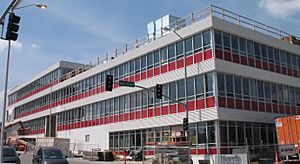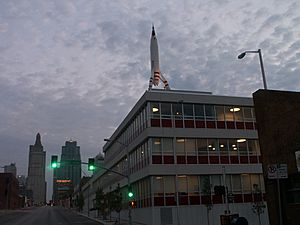TWA Corporate Headquarters Building facts for kids
The TWA Corporate Headquarters Building is a famous building in Kansas City, Missouri. It used to be the main office for Trans World Airlines (TWA), a big airline. TWA moved its main office to New York City in 1964, but this building still has a lot of history! It's located in the Crossroads area of downtown Kansas City.
Quick facts for kids |
|
|
TWA Corporate Headquarters Building
|
|
 |
|
| Location | Kansas City, Missouri |
|---|---|
| Area | less than one acre |
| Built | 1955-1956 |
| Architect | Raymond E. Bales, Jr. and Morris Schechter |
| Architectural style | International style, Miesian |
| NRHP reference No. | 02001403 |
| Added to NRHP | November 20, 2002 |
Contents
Building a Landmark: TWA's First Home
Kansas City was chosen as TWA's main office location. Some say that famous pilot Charles Lindbergh helped make this decision. The building was designed by architects Raymond E. Bales, Jr. and Morris Schechter. Construction started in May 1955 and finished in October 1956.
The outside of the building was decorated in TWA's special red and white colors. It was a three-story building shaped like an "L." It had cool aluminum panels and wavy concrete panels. The builders used a special method called Youtz-Slick construction. This method helped them build faster and save money.
TWA Moves On: A New Chapter
By 1964, TWA had grown into a huge international airline. Because of this, they decided to move their main executive offices to New York City.
However, the building at 1735 Baltimore Avenue was still used by TWA. It housed departments like accounting, ticket sales, and cargo until 1969. TWA also used the building to train its flight attendants. Later, they opened a new training center called the Breech Academy in Overland Park, Kansas.
Saving History: The Building's Restoration
In 2002, the TWA building was added to the National Register of Historic Places. This means it's an important historical site. The building was empty for several years.
In 2005, a company called The Nicholson Group decided to restore it. They hired an architectural firm, el dorado inc, to help. After the building was fixed up, an advertising agency called Barkley Inc. moved in on November 14, 2006.
The TWA Moonliner II: A Rocket on the Roof
During TWA's busiest years, its headquarters building was easy to spot. This was thanks to a 22-foot-tall rocket called the TWA Moonliner II on its roof. This rocket was a smaller version of the 76-foot-tall TWA Moonliner at Disneyland's Tomorrowland. TWA was the main sponsor of the Disneyland rocket until 1962.
The original Moonliner II was taken off the building's roof after Howard Hughes sold his part of the airline. It was then sold to a company that made travel trailers.
The Moonliner's Journey and Return
When the travel trailer company moved in 1970, the Moonliner II went with them. It was left outside and slowly started to fall apart over 25 years. It stood near their factory, close to Interstate 70.
Later, a Disney collector bought the damaged Moonliner replica. He carefully restored it, giving it back its original red and white TWA colors. Today, the restored Moonliner II is on display at the National Airline History Museum in Kansas City. This museum is located at the Charles B. Wheeler Downtown Airport.
A New Moonliner for a Restored Building
When the TWA headquarters building was restored, people wanted to bring back the iconic rocket. So, a brand new Moonliner II replica was built starting in March 2006. This new rocket was installed on September 29, 2006, in the same spot on the roof as the original.





